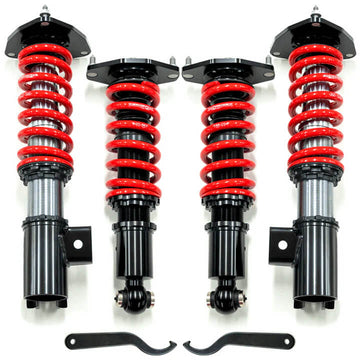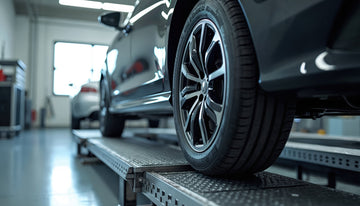A helper spring refers to a type of spring commonly used in vehicle suspension systems. It is typically a compact, slender, and flat wire spring that is positioned in-line with the main spring. The primary function of the helper spring is to ensure continuous contact and engagement between the main spring and its upper and lower seats throughout the entire range of suspension travel.
By maintaining constant pressure on the main spring, the helper spring helps prevent the main spring from becoming dislodged or disengaged during extreme suspension movements. It effectively supports the main spring, preventing it from fully extending or compressing beyond its intended limits. This ensures that the suspension system remains in proper alignment, enhancing stability, control, and overall ride quality.
Helper springs are particularly useful in scenarios where vehicles encounter heavy loads, uneven terrain, or dynamic driving conditions that could cause the main spring to lose contact with its seating surfaces. By providing supplemental support, helper springs contribute to a more consistent and controlled suspension performance, minimising the risk of bottoming out, sagging, or compromising the vehicle's handling characteristics.
What are the benefits of helper springs?
Helper springs offer several benefits in vehicle suspension systems. Below are some key advantages of using helper springs:
Increased load-carrying capacity
One of the primary benefits of helper springs is their ability to enhance the load-carrying capacity of a vehicle, resulting in a greater load rate. By providing additional support to the main springs and coilover springs, helper springs help counteract the effects of heavy loads, such as when towing a trailer or carrying a significant amount of cargo. They prevent excessive sagging and ensure that the vehicle maintains a level ride height, which improves overall stability and handling while accommodating a greater load rate.
Improved suspension performance
Helper springs, including coilover springs, contribute to improved suspension performance by reducing the risk of bottoming out. When encountering large bumps or dips in the road, the helper springs engage to provide additional resistance and support. This prevents the primary springs from fully compressing and hitting their limits, resulting in a smoother ride and minimising the chances of damaging the suspension components.
Enhanced control and stability
By maintaining a more stable ride height and preventing excessive suspension compression, including the integration of coilover springs, helper springs help improve control and stability while driving. They minimise the tendency for the vehicle to sway, pitch, or roll during manoeuvres, enhancing overall handling and safety, particularly when carrying heavy loads or travelling over uneven terrain.
Extended suspension lifespan
The presence of helper springs helps distribute the load more evenly across the suspension system, reducing the strain on individual components. By preventing the primary springs from being overly compressed, they help minimise wear and tear, extending the lifespan of the suspension components, including shocks, struts, and other related parts.
Versatility
Helper springs offer versatility and adjustability to meet specific load requirements, allowing for flexibility in adapting the suspension to varying conditions. Helper springs are suitable for a range of applications, including commercial vehicles, towing setups, off-road vehicles, and recreational vehicles.
Spring Maintenance: Learn How to Properly Maintain and Extend the Life of Your Springs
Maintaining helper springs is essential to ensure their optimal performance and longevity. Below are some general guidelines for maintaining helper springs:
Regular inspection
Periodically inspect the helper springs to check for any signs of damage, such as cracks, corrosion, or deformation. Also, inspect the mounting hardware, including bolts, brackets, and bushings, for any signs of wear or looseness. If you notice any issues, address them promptly.
Clean and lubricate
Clean the helper springs and associated components regularly to remove dirt, debris, and road grime that may accumulate over time. Use a mild detergent and water solution, along with a soft brush or cloth, to clean the springs thoroughly. After cleaning, apply a suitable lubricant to the mounting hardware, ensuring smooth operation and preventing corrosion.
Check alignment
Verify that the helper springs are properly aligned and centred within the suspension system. Misalignment can cause uneven stress distribution, leading to premature wear or reduced effectiveness. If you notice misalignment, consult a professional to correct the issue and realign the helper springs.
Monitor load capacity
Helper springs are designed to support specific load capacities, including achieving a greater load rate. Avoid exceeding the recommended load capacity to prevent excessive strain on the springs and potential damage. Regularly evaluate the weight being carried and ensure it falls within the manufacturer's specified limits for safety and greater load rate.
Address abnormal behaviour
If you notice any unusual behaviour in the suspension system, such as excessive sagging, bouncing, or noise during compression, have the helper springs inspected by a professional. These symptoms may indicate a problem with the springs or other suspension components that require attention.
Professional inspection and maintenance
Periodically have a professional suspension specialist or mechanic inspect the entire suspension system, including the helper springs and coilover springs, for comprehensive maintenance. They can assess the condition, functionality, and alignment of the helper springs, including the coilover springs, and identify any potential issues or areas that need adjustment or replacement. This proactive approach to inspection and maintenance helps maintain the performance, safety, and longevity of the entire suspension system, including the crucial components like the helper springs and coilover springs.
Spring Failure Analysis: Identify and Prevent Common Causes of Spring Failures
Understanding the causes of spring failures is essential for optimal performance and preventing costly disruptions. Springs are vital components in many industries, supporting critical mechanisms. By identifying and addressing common causes of spring failures, their reliability and lifespan can be significantly improved.
One common cause of spring failures is subjecting them to a greater load rate than they can handle. When a spring is subjected to excessive stress, fatigue can set in, eventually leading to failure. It is essential to consider the load rate and ensure it falls within the spring's specified capacity.
Another factor to consider is the maintenance and condition of shock absorbers. Faulty or poorly maintained shock absorbers can impose irregular and excessive forces on the springs. These forces can accelerate wear and tear, compromising their performance and longevity. Regular inspections and timely replacement of shock absorbers are critical preventive measures.
In certain applications, helper springs can also play a role in preventing spring failures. Helper springs are commonly used alongside coilover springs to enhance support and stability. They distribute the load and reduce stress on the primary spring, preventing early failure and ensuring longevity.
To prevent spring failures, a comprehensive approach is necessary. Regular inspections, considering load rates, and maintaining shock absorbers and helper springs are crucial. Implementing these measures improves the reliability and durability of spring systems, reducing downtime and expensive repairs.





